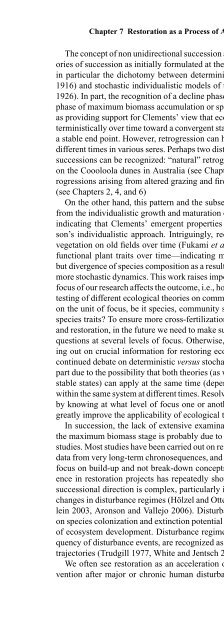Linking Restoration and Ecological Succession (Springer ... - Inecol
Linking Restoration and Ecological Succession (Springer ... - Inecol
Linking Restoration and Ecological Succession (Springer ... - Inecol
You also want an ePaper? Increase the reach of your titles
YUMPU automatically turns print PDFs into web optimized ePapers that Google loves.
Chapter 7 <strong>Restoration</strong> as a Process of Assembly <strong>and</strong> <strong>Succession</strong> Mediated by Disturbance 155<br />
The concept of non unidirectional succession allows a reconsideration of theories<br />
of succession as initially formulated at the beginning of the 20th century,<br />
in particular the dichotomy between deterministic climax models (Clements<br />
1916) <strong>and</strong> stochastic individualistic models of terrestrial succession (Gleason<br />
1926). In part, the recognition of a decline phase in succession after reaching a<br />
phase of maximum biomass accumulation or species richness could be viewed<br />
as providing support for Clements’ view that ecosystems can develop quite deterministically<br />
over time toward a convergent state with a maximum biomass or<br />
a stable end point. However, retrogression can happen in different ways <strong>and</strong> at<br />
different times in various seres. Perhaps two distinct categories of retrogressive<br />
successions can be recognized: “natural” retrogressions, such as that observed<br />
on the Coooloola dunes in Australia (see Chapter 4), <strong>and</strong> human-induced retrogressions<br />
arising from altered grazing <strong>and</strong> fire regimes, mining, <strong>and</strong> the like<br />
(see Chapters 2, 4, <strong>and</strong> 6)<br />
On the other h<strong>and</strong>, this pattern <strong>and</strong> the subsequent decline phase can result<br />
from the individualistic growth <strong>and</strong> maturation of particular dominant species,<br />
indicating that Clements’ emergent properties can be explained using Gleason’s<br />
individualistic approach. Intriguingly, recent work on the assembly of<br />
vegetation on old fields over time (Fukami et al. 2005) found convergence of<br />
functional plant traits over time—indicating more deterministic dynamics—<br />
but divergence of species composition as a result of priority effects—indicating<br />
more stochastic dynamics. This work raises important issues of how the level of<br />
focus of our research affects the outcome, i.e., how dependent is our hypothesistesting<br />
of different ecological theories on community succession <strong>and</strong> assembly<br />
on the unit of focus, be it species, community structure, functional groups, or<br />
species traits? To ensure more cross-fertilization between community ecology<br />
<strong>and</strong> restoration, in the future we need to make sure we try to answer the critical<br />
questions at several levels of focus. Otherwise, we may be unwittingly missing<br />
out on crucial information for restoring ecosystems. It could well be that<br />
continued debate on deterministic versus stochastic theories of ecosystem is in<br />
part due to the possibility that both theories (as well as the theory of alternative<br />
stable states) can apply at the same time (depending on the level of focus) or<br />
within the same system at different times. Resolving this major issue in ecology,<br />
by knowing at what level of focus one or another theory applies, would help<br />
greatly improve the applicability of ecological theory to restoration.<br />
In succession, the lack of extensive examination of the decline phase after<br />
the maximum biomass stage is probably due to the shorter timescale of earlier<br />
studies. Most studies have been carried out on relatively young l<strong>and</strong>scapes, lack<br />
data from very long-term chronosequences, <strong>and</strong> illustrate a bias of successional<br />
focus on build-up <strong>and</strong> not break-down concepts (see also Chapter 4). Experience<br />
in restoration projects has repeatedly shown, however, that the story of<br />
successional direction is complex, particularly in a world experiencing drastic<br />
changes in disturbance regimes (Hölzel <strong>and</strong> Otte 2003, Jentsch <strong>and</strong> Beierkuhnlein<br />
2003, Aronson <strong>and</strong> Vallejo 2006). Disturbance <strong>and</strong> its interactive effects<br />
on species colonization <strong>and</strong> extinction potential are a vital part of the dynamics<br />
of ecosystem development. Disturbance regimes, including intensity <strong>and</strong> frequency<br />
of disturbance events, are recognized as critical drivers of successional<br />
trajectories (Trudgill 1977, White <strong>and</strong> Jentsch 2001).<br />
We often see restoration as an acceleration of succession via human intervention<br />
after major or chronic human disturbance. The issue is whether the

















